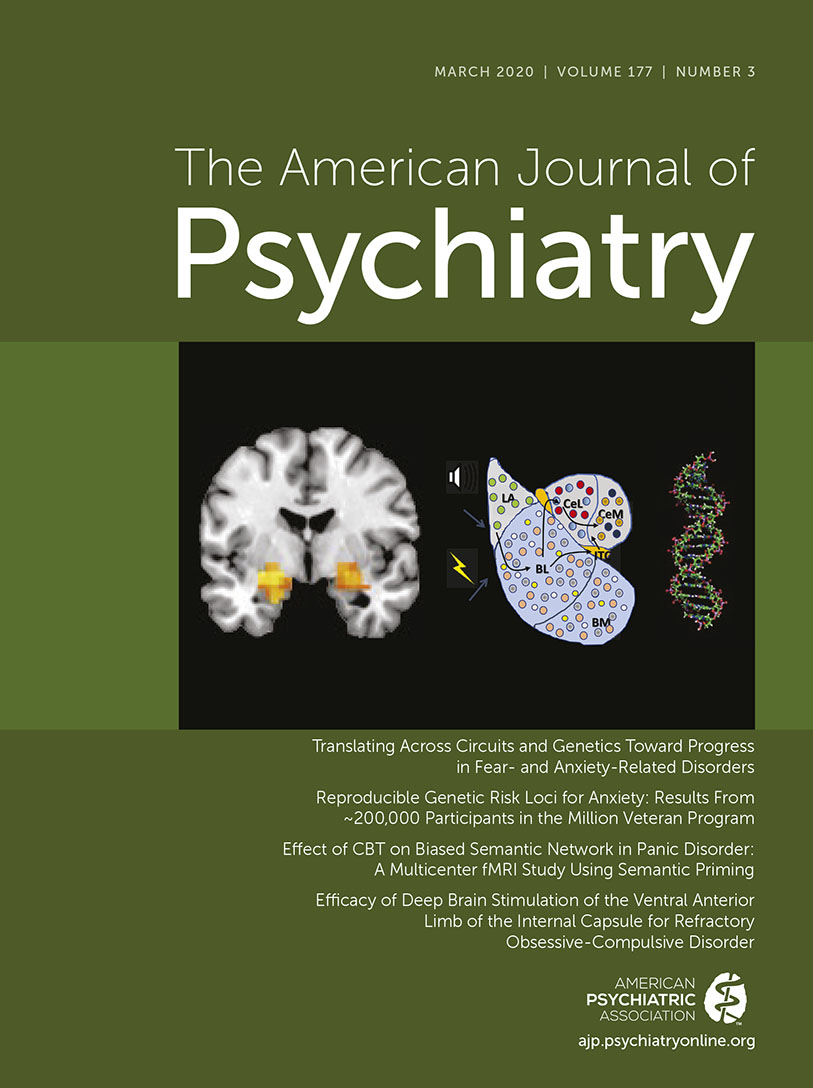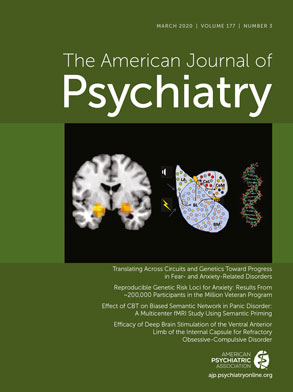What are the core mechanisms by which exposure therapy for anxiety disorders enables symptom reduction? This is a long-standing question that highlights the interplay between clinical science and clinical practice: better understanding of our treatments at a mechanistic level provides us the knowledge to develop, test, and provide better treatments. With respect to exposure therapy (initially referred to as systematic desensitization: exposure to feared stimuli with concurrent muscle relaxation), the initial conceptualization focused on reciprocal inhibition (
1): pairing an anxiety-related stimulus with an incompatible relaxed physiological state was hypothesized to be required to inhibit the anxious physiological state. Subsequent studies dismantling systematic desensitization into its individual components (exposure to feared stimuli and progressive relaxation) demonstrated that exposure therapy without relaxation performed just as well as it did with relaxation (
2), failing to support the initial mechanistic account.
The widely influential emotion processing theory (
3) posited three essential processes through which exposure therapy might weaken an existing fear structure: 1) initial fear activation; the exposure must actually activate or elicit the fear structure; 2) within-session habituation; the initial fear reactivity must attenuate within the session; and 3) between-session habituation; the degree of fear responding from one session to the next must decrease. While there was initial support for each of these processes, subsequent research provided much better support for initial fear activation and between-session habituation relative to within-session habituation (
4,
5). Current conceptualizations of exposure therapy have modified the original emotion processing theory (
4,
6) and, guided by basic research on fear extinction (
7–
10), focus more on inhibitory learning—that is, forming a new safety association with the anxiety-related stimulus that functions to inhibit retrieval of the original fear association.
The article by Yang et al. in this issue (
11) describes an interesting study that adds to this broader context of the long history of understanding how exposure therapy works so that we can improve it. In addition to providing novel insights into mechanisms of treatment response, the Yang et al. report also highlights the inherent difficulty in studying this topic and the importance of nuanced methodological considerations.
Building on the framework of Lang’s bioinformational theory (
12) that emotional imagery activates an associative network of stimulus-related information (e.g., perceptual, semantic, and response propositions about the stimulus), the authors used a lexical decision-making task to probe a panic-disorder-relevant semantic network. In this task, participants made decisions about whether a presented series of letters was a word or a nonword. Critically, the words were preceded by either a panic-trigger word or a neutral word. A panic disorder semantic network would consist of strong associations between panic triggers (e.g., elevator) and symptom words (e.g., dizzy). Thus, individuals with panic disorder should respond faster to symptom words that were preceded by trigger words because those trigger words activate the semantic network and subsequently make decisions about the symptom words easier.
This research group had previously used this task in a cohort of individuals with high anxiety sensitivity (a robust risk factor for panic disorder) and found evidence of panic priming in the anterior insula, inferior frontal gyrus, and lateral prefrontal and parietal cortices (
13). In the present study, a large cohort of patients with panic disorder and healthy control subjects (N>100, depending on the measure) completed this task during fMRI, at time 1 (T1). A subset of panic disorder patients who completed a version of exposure therapy (different lengths of exposure therapy were tested) completed the task again after treatment (N=39), at time 2 (T2). A subset of the healthy control group also completed the task again at T2.
The authors found that at the pretreatment assessment, the panic disorder group rated symptom words preceded by trigger words as more related and higher in negative valence and were faster in making lexical decisions compared with the control group. The authors also found at the pretreatment assessment that the panic disorder group had greater activation relative to the control group in response to symptom words preceded by trigger words in a distributed network including the perigenual anterior cingulate cortex (ACC) and posterior cingulate cortex (PCC). These findings suggest a panic disorder semantic network, such that there is increased semantic connectivity between trigger words and symptom words in individuals with panic disorder, and the authors were able to demonstrate this using both behavioral and imaging measures.
After treatment, a group-by-time interaction supported decreased relatedness and negative valence for symptom words preceded by panic trigger words in the panic disorder group. The interaction was not supported for reaction times. Constrained within a mask of voxels that differed at the pretreatment assessment, the authors found group-by-time interactions in the ACC and the PCC, suggesting decreased ACC encoding of panic priming in the panic disorder group after treatment (but increased ACC encoding in the control group; see below). The authors found that pre- to posttreatment changes in panic disorder symptoms were correlated with pre- to posttreatment changes in relatedness ratings during word rating. They also found that pre- to posttreatment changes in a separate measure of agoraphobic symptoms were correlated with pre- to posttreatment changes in ACC activity during panic priming (although this effect appeared to emerge only when an outlier was removed). Results from the treatment-related aspect of this study suggest that exposure therapy may enable symptom reduction through weakening of a semantic network and associated decreased encoding of this semantic connectivity in the ACC. From the perspective of identifying mechanisms of exposure therapy for the sake of improving its efficacy, these results suggest a potential for developing more potent ways of tailoring exposure exercises to more robustly weaken the semantic network component of the fear structure.
The study has numerous strengths, including a multicenter design, a large initial sample size, a well-defined study sample, a theoretically driven and psychopathology-relevant task, and the use of a healthy control group for comparison with normative performance. At the same time, there are numerous challenges in interpreting the findings with respect to mechanisms of exposure therapy treatment response, which highlights the difficulty in precisely defining these mechanisms. The lack of a panic disorder treatment comparison group precludes strong inferences about exposure therapy specifically. Credible psychological treatments produce symptom improvement through both specific (e.g., exposure) and nonspecific treatment components (
14) (e.g., attention, rationale, ritual, etc.). That there was only one treatment condition makes it impossible to know whether any treatment effects detected in this study are due to exposure therapy specifically or to general, nonspecific effects of treatment. Relatedly, because the study did not include a panic disorder group that received no treatment, it is unclear what the simple effect of time had on responding. This is particularly important, as the statistical interaction that provided support for the key finding of reduced ACC activation at the posttreatment assessment in the panic disorder group was probably driven as much by increased activation in the healthy group at T2 as by reduced activation in the panic group. That is, it was just as much the case that the healthy group increased their ACC activation during the second fMRI scan as the panic disorder group decreased their ACC activation at their second fMRI scan. This altered time-related pattern in the control group precluded strong inferences regarding the functional relevance of the initial heightened ACC activity in the panic disorder group and whether reduced ACC activity should actually be a target of treatment.
While the correlation between treatment-related reductions in the ACC and treatment-related reductions in agoraphobic avoidance are consistent with a mechanism of treatment response, there are also interpretive difficulties with these analyses. A general principle for defining a causal mechanism is temporal precedence (
15): the cause must precede the effect. In this case, agoraphobic avoidance and ACC responding were defined at the same time, so it is equally plausible that reductions in symptoms cause reductions in ACC responding rather than the reverse. This highlights the essential methodological component of multiple measurement points. Having a midtreatment assessment time point would allow for a time-lagged analysis to determine whether initial changes in the hypothesized mediator (e.g., ACC activity) predicted subsequent reductions in symptoms (see references
16,
17 for some interesting examples with exposure therapy for posttraumatic stress disorder). Relatedly, the authors tested correlations between three symptom measures and seven potential mediators (i.e., 21 correlation tests), but it is not clear whether these measures were integrated, and hypothesis-driven mediation analyses were not performed.
The study by Yang et al. is consistent with the bioinformational theory of fear structures (
12) and with the hypothesis that exposure therapy for panic disorder may work through modifying the semantic network within this fear structure and thereby suggests potential ways to optimize delivery of exposure therapy. At the same time, the study also highlights some key methodological features of clinical trials needed to maximize the precision of inferences. First, the strength of inference would improve with some type of active comparison group to differentiate exposure-specific effects from nonspecific treatment effects. Second, the strength of inference would improve with assessments at multiple time points (i.e., a minimum of three) in order to conduct lagged analyses and demonstrate temporal precedence of the hypothesized mediators. Third, the strength of inference would improve with formal statistical tests of mediation (
18) to explicitly test the hypothesized mediation pathway: exposure alters a particular mechanism, which subsequently enables symptom reduction. While imperfect and difficult and expensive to conduct, this study by Yang et al. contributes to a body of work with the goal of advancing our scientific knowledge so that we can provide better treatments to our patients.

